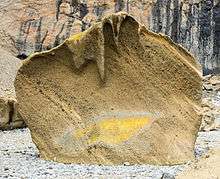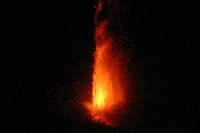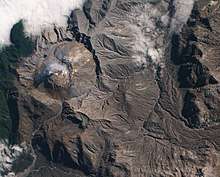Tephra
Tephra is fragmental material produced by a volcanic eruption regardless of composition, fragment size, or emplacement mechanism.[1]

Volcanologists also refer to airborne fragments as pyroclasts. Once clasts have fallen to the ground, they remain as tephra unless hot enough to fuse together into pyroclastic rock or tuff. Tephrochronology is a geochronological technique that uses discrete layers of tephra—volcanic ash from a single eruption—to create a chronological framework in which paleoenvironmental or archaeological records can be placed. When a volcano explodes, it releases a variety of tephra including ash, cinders, and blocks. These layers settle on the land and, over time, sedimentation occurs incorporating these tephra layers into the fossil record. Often, when a volcano explodes, biological organisms are killed and their remains are buried within the tephra layer. These fossils are later dated by scientists to determine the age of the fossil and its place within the fossil record.

Overview
Tephra is unconsolidated pyroclastic material produced by a volcanic eruption. It consists of a variety of materials, typically glassy particles formed by the cooling of droplets of magma, which may be vesicular, solid or flake-like, and a varying proportions of crystalline and mineral components originating from the mountain and the walls of the vent. As the particles fall to the ground, they are sorted to a certain extent by the wind and gravitational forces and form layers of unconsolidated material. The particles are further moved by ground surface or submarine water flow.[2]
The distribution of tephra following an eruption usually involves the largest boulders falling to the ground quickest, therefore closest to the vent, while smaller fragments travel further – ash can often travel for thousands of miles, even circumglobal, as it can stay in the stratosphere for days to weeks following an eruption. When large amounts of tephra accumulate in the atmosphere from massive volcanic eruptions (or from a multitude of smaller eruptions occurring simultaneously), they can reflect light and heat from the sun back through the atmosphere, in some cases causing the temperature to drop, resulting in a temporary "volcanic winter". The effects of acidic rain and snow, the precipitation caused by tephra discharges into the atmosphere, can be seen for years after the eruptions have stopped. Tephra eruptions can affect ecosystems from miles to kilometers depending on the size of the eruption.[3]
Classification
Tephra fragments are classified by size:
- Ash – particles smaller than 2 mm (0.08 inches) in diameter
- Lapilli or volcanic cinders – between 2 and 64 mm (0.08 and 2.5 inches) in diameter
- Volcanic bombs or volcanic blocks – larger than 64 mm (2.5 inches) in diameter
The use of tephra layers, which bear their own unique chemistry and character, as temporal marker horizons in archaeological and geological sites, is known as tephrochronology.[2]
Etymology
The word "tephra" and "pyroclast" both derive from Greek: τέφρα tephra means "ash",[4] while the word pyroclast is derived from the Greek πῦρ (pyr), meaning "fire",[5] and κλαστός (klastos), meaning "broken in pieces".[6]
Environmental Impacts
The release of tephra into the troposphere impacts the environment physically and chemically. Physically, volcanic blocks damage local flora and human settlements. Ash damages communication and electrical systems, coats forests and plant life reducing photosynthesis, and pollutes groundwater.[7] Tephra changes below and above ground air and water movement. Chemically, tephra release can impact the water cycle. Tephra particles can cause ice crystals to grow in clouds which increases precipitation. Nearby watersheds and the ocean can experience elevated mineral levels, especially iron, which can cause explosive population growth in plankton communities.[3] This, in turn, can result in eutrophication.
Disciplines and the Fossil Record
In addition to tephrochronology, tephra is used by a variety of scientific disciplines including geology, paleoecology, anthropology, and paleontology, to date fossils, identify dates within the fossils record, and learn about prehistoric cultures and ecosystems. The carbonatite ash found in tephra serves as a fossilization catalyst burying and preserving fossils and tephra blocks near the site of the eruption. Under certain conditions, volcanic blocks can be preserved for billions of years and can travel up to 400 km away from the eruption. Volcanic eruptions around the world have provided valuable scientific information on local ecosystems and ancient cultures.
Volcanoes (Selected by Continent)
Africa
Africa's volcanoes have had a strong impact on the fossil record. Geographically, a part of Africa, El Hierro, a shield volcano, is located off the coast of El Hierro Island, the newest and smallest of the Canary Islands, The most recent El Hierro eruption occurred underwater, in 2011, and caused earthquakes and landslides throughout the Canary Islands. Instead of ash, floating rocks, restingolites, are released after every eruption.[8] After the 2011 eruption, fossils of single-celled marine organisms were found in the restingolites verifying the origin theory that Canary Island growth comes from a single buoyant jet of magma from the Earth's core instead of cracks in the ocean floor. This is reflected in the decreasing age of the islands east to west from Fuerteventura to El Hierro.[9] There are about 60 volcanoes in Ethiopia, located in east Africa. In Southern Ethiopia, the Omo Kibish Rock Formation is composed of layers of tephra and sediment. Within these layers, several fossils have been discovered. In 1967, 2 Homo sapien fossils were discovered in the Omo Kibish Formation by Richard Leaky, a paleoanthropologist. After radiocarbon dating, they were determined to be 195 thousand years old.[10] Other mammals discovered in the formation include Hylochoerus meinertzhageni (forest hog) and Cephalophus (antelope).[11]
Antarctica
Antarctica has a unique volcanic history. Today, volcanic activity occurs on islands located off the coast of Antarctica. One of the most active islands is Ross Island which has 4 volcanoes: Mount Erebus, Mount Terror, Mount Bird, and Mount Haddington. The most active of these four volcanoes is Mount Erebus, a stratovolcano, which has been continuously erupting since 2019 and is most famous for its lava lake.[12] About 252 million years ago, the Permian-Triassic extinction event marked the transition between the Paleozoic era and Mesozoic era. This event included repeated meteor strikes which produced large volcanic eruptions releasing large quantities of methane gas into the atmosphere. During this time, Antarctica was still attached to South America. When the volcanoes erupted, whole forests growing in Antarctica were covered in lava. In 2015, a group of researchers led by Erik Gulbranson, professor at the University of Wisconsin–Milwaukee, discovered the Allan Hills fossil forest which dates back to the Triassic Period, about 252 to 200 million years ago.[13] Many fossil forests have been found throughout Antarctica and are of interest to scientists around the world.
Asia
In Asia, several volcanic eruptions are still influencing local cultures today. In North Korea, Paektu Mountain, a stratovolcano, first erupted in 946 AD and is a religious site for locals. It last erupted in 1903. In 2017, new fossil evidence was discovered that determined the date of Paektu Mountain's first eruption, which had been a mystery. A team of scientists directed by Dr. Clive Oppenheimer, British volcanologist, discovered a larch trunk embedded within Paektu Mountain. After radiocarbon dating, the larch was determined to be 264 years old which coincides with the 946 AD eruption. Its tree rings are being studied and many new discoveries are being made about North Korea during that time.[14]
In northeastern China, a large volcanic eruption in the early Cretaceous caused the fossilization of an entire ecosystem known as the Jehol Biota when powerful pyroclastic flows inundated the area. The deposits include many perfectly preserved fossils of dinosaurs, birds, mammals, reptiles, fish, frogs, plants, and insects.[15]
Australia
Australia's newly discovered prehistoric volcanoes are of interest to scientists worldwide because, at present, they are the oldest in Australia. There are only 2 active volcanoes in Australia, one located on Heard Island and McDonald Island.[16] However, in 2019, about 100 prehistoric volcanoes were discovered underneath the Cooper-Eromanga Basins by teams of scientists from the University of Adelaide in Australia and the University of Aberdeen in Scotland. These volcanoes date back to the Jurassic Period, 160 to 180 million years ago. Researchers are excited about discovering more volcanoes underneath Australia and learning more about Australia's landscape during the Jurassic Period.[17]
Europe
Europe's volcanoes provide unique information about the history of Italy. Mount Vesuvius, a stratovolcano, last erupted in March 1944, located in southern Italy.[18] In 79 AD, Mount Vesuvius erupted covering the city of Pompeii in molten lava, ash, pumice volcanic blocks, and toxic gases. The entire eruption lasted 12 to 18 hours. Afterwards, everything was perfectly preserved and fossilized by the volcanic ash and has provided valuable information about the Roman culture.[19] Also, in Italy, Stromboli volcano, a stratovolcano, last erupted in July 2019. In 2013, a team of researchers led by Ingrid Smet and Dr. Tom Pfeiffer, volcanologists, discovered dinosaur fossil footprints, from Diplodocus hallorum, in thick layers of ash.[20]
North America
.jpg)
Several volcanic eruptions have been studied in North America. On 18 May 1980, Mt. Saint Helens, a stratovolcano, in Washington state erupted spreading five hundred million tons of tephra ash across Washington, Montana and Idaho causing earthquakes, rockslides, and megatsunami which severely altered the topography of nearby areas.[21] The effects of the Mt. Saint Helens eruption was felt as far away as Yellowstone National Park, where eruption related flooding caused trees to collapse and wash into lake beds where they fossilized. Nearby forests were flooded, removing bark, leaves, and tree limbs.[22] In 2006, the Augustine Volcano in Alaska erupted generating earthquakes, avalanches, and projected tephra ash approximately two hundred and ninety kilometers away. This dome volcano is over forty thousand years old and has erupted 11 times since 1800.[23]
South America

In South America, there are several historic active volcanoes. In southern Chile, the Chaitén volcano erupted in 2011 adding 160 meters to its rim. Prehistoric weapons and tools, formed from obsidian tephra blocks, were dated at 5,610 years ago and were discovered 400 km away.[24] Due to the location of the subduction zone of the eastern Pacific's Nazca Plate, there are twenty one active volcanoes in southern Peru.[25] In 2006, fossils, found under a layer of volcanic ash in Peru, were excavated by a team of paleontologists led by Mark D. Uhen, professor at George Mason University. The fossils were identified as 3 different types of archaeocetes, prehistoric whales, and are older than 36.61 million years which, as of 2011, makes them the oldest whale fossils discovered.[26]
References
- This is the broad definition of tephra (Greek tephra, "ash") proposed by the Icelandic volcanologist Sigurður Þórarinsson (Sigurdur Thorarinsson) in 1954, in connection with the eruption of Hekla (Thorarinsson, "The eruption of Hekla, 1947-48II, 3, The tephra-fall from Hekla, March 29th, 1947", Visindafélag Íslendinga (1954:1-3).
- Gornitz, Vivien (2008). Encyclopedia of Paleoclimatology and Ancient Environments. Springer Science & Business Media. pp. 937–938. ISBN 978-1-4020-4551-6.
- Ayris, Paul Martin; Delmelle, Pierre (1 November 2012). "The immediate environmental effects of tephra emission". Bulletin of Volcanology. 74 (9): 1905–1936. Bibcode:2012BVol...74.1905A. doi:10.1007/s00445-012-0654-5. ISSN 1432-0819.
- τέφρα. Liddell, Henry George; Scott, Robert; A Greek–English Lexicon at the Perseus Project.
- πῦρ in Liddell and Scott.
- κλαστός in Liddell and Scott.
- "USGS: Volcano Hazards Program". volcanoes.usgs.gov. Retrieved 19 March 2020.
- "Global Volcanism Program | Hierro". Smithsonian Institution | Global Volcanism Program. Retrieved 19 March 2020.
- "Fossils survive volcanic eruption to tell us about the origin of the Canary Islands". ScienceDaily. Retrieved 19 March 2020.
- Brown, Francis H.; Fuller, Chad R. (September 2008). "Stratigraphy and tephra of the Kibish Formation, southwestern Ethiopia". Journal of Human Evolution. 55 (3): 366–403. doi:10.1016/j.jhevol.2008.05.009. PMID 18692219.
- Assefa, Zelalem; Yirga, Solomon; Reed, Kaye E. (September 2008). "The large-mammal fauna from the Kibish Formation". Journal of Human Evolution. 55 (3): 501–512. doi:10.1016/j.jhevol.2008.05.015. PMID 18691734.
- "Erebus". www.volcanodiscovery.com. Retrieved 19 March 2020.
- "Video: Research team discovers plant fossils previously unknown to Antarctica". www.nsf.gov. Retrieved 19 March 2020.
- "Fossilized tree and ice cores help date huge volcanic eruption 1,000 years ago to within three months". ScienceDaily. Retrieved 19 March 2020.
- "Pompeii-style volcano gave China its dinosaur trove". phys.org. Retrieved 19 March 2020.
- Australia, c\=AU\;o\=Australia Government\;ou\=Geoscience (20 October 2017). "Volcano". www.ga.gov.au. Retrieved 19 March 2020.
- "Jurassic world of volcanoes found in central Australia". ScienceDaily. Retrieved 19 March 2020.
- "Everything about the volcanoes in Italy". ZME Science. 24 September 2015. Retrieved 19 March 2020.
- Editors, History com. "Mount Vesuvius erupts". HISTORY. Retrieved 19 March 2020.CS1 maint: extra text: authors list (link)
- "Discovery: fossil dinosaur footprints in volcanic ash layers might challenge date of dinosaur extinction | VolcanoDiscovery". www.volcanodiscovery.com. Retrieved 19 March 2020.
- "Cascades Volcano Observatory". volcanoes.usgs.gov. Retrieved 19 March 2020.
- Discoveries, Amazing. "Petrified Trees | Fossilized Trees | Mount St. Helens Eruption". amazingdiscoveries.org. Retrieved 19 March 2020.
- "Augustine | Volcano World | Oregon State University". volcano.oregonstate.edu. Retrieved 19 March 2020.
- "Chaitén Volcano, Chile: Map, Facts, Eruption Pictures | Chaiten". geology.com. Retrieved 19 March 2020.
- "Volcanoes of Peru". www.volcanodiscovery.com. Retrieved 19 March 2020.
- Pyenson, Nicholas D. "New Archaeocetes from Peru Are the Oldest Fossil Whales from South America | Smithsonian Ocean". ocean.si.edu. Retrieved 19 March 2020.
External links

- How Volcanoes Work
- Volcanic Materials Identification
- Pictures of lunar landscape between Guatiza and Teseguite in Lanzarote
